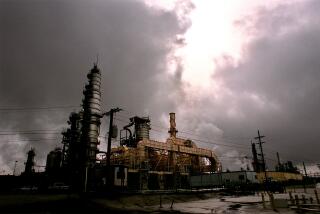Oil Prices Drop Below $17 as Traders Turn Bearish
- Share via
Oil prices plunged through the critical $17-a-barrel barrier Tuesday for the first time in more than two months over growing skepticism over OPEC’s ability to hold down production and achieve its $18 price target.
On the New York Mercantile Exchange, West Texas Intermediate crude oil, the benchmark U.S. crude for immediate delivery, plummeted 35 cents to $16.73 a barrel.
It was the lowest close since West Texas Intermediate ended at $16.91 a barrel on Dec. 23, three days after OPEC agreed to cut production by 7.2% to 15.8 million barrels a day in a bid to lift oil prices to an official average of $18 a barrel by Feb. 1.
West Texas Intermediate hit a high for the year of $19.14 a barrel on Jan. 15, propelled by optimism that the Organization of Petroleum Exporting Countries would pull off its high-stakes attempt to stabilize prices at $18 a barrel.
West Texas Intermediate fell by 65 cents to $16.85 a barrel on the U.S. Gulf Coast spot market Tuesday, where oil is sold to the highest bidder.
Unleaded gasoline for immediate delivery on the Merc tumbled 1.10 cents to 45.89 cents a gallon and home-heating oil slipped 0.82 cent to 45.01 cents.
On the European spot market, where oil is sold to the highest bidder, Britain’s North Sea Brent crude nose dived by 60 cents to $16.45 a barrel, the lowest close since mid-December. Brent traded as high as $18.80 on Jan. 12.
“Traders have turned bearish on oil,” said Andrew Lebow, an analyst in New York with Shearson Lehman Bros.
Two factors are at work, he said. Poor refinery profit margins are putting pressure on crude prices and there is diminishing optimism about the ability of OPEC to hold to its production control agreement.
In the Dec. 20 accord, OPEC vowed to limit its output in order to boost prices to a target level of $18 per 42-gallon barrel. The pact appeared to be working by late January, when a combination of severe winter weather and growing belief that the agreement would stick had pushed prices well above $18.
But, Lebow observed: “Refinery runs have been much higher than they should have been for the last six weeks. As a result there’s been a considerable buildup in gasoline stocks, and in heating oil stocks, as well.”
The surplus has put pressure on oil product prices to the extent that some crude oil is being refined at a loss, Lebow said.
“If I know I’m going to lose money on every barrel I refine, why would I buy oil at some fixed price? I wouldn’t,” he said.
This is going to make it difficult for members of OPEC to keep prices fixed around $18.
“The next couple of weeks are going to be crucial,” he said.
But refinery runs are going to have to be cut, Lebow said, and this will lead to better prices for oil products and renewed demand for crude.
Despite the difficulties, he said, OPEC probably will hold to the agreement.
“I don’t think they have the stomach for the kind of price war we saw in 1986,” he said.
During the past five weeks, oil prices have eroded steadily by about $2 a barrel on reports OPEC was exceeding its self-imposed production ceiling by nearly 1 million barrels a day because of quota violations by Iraq, Kuwait, the United Arab Emirates and Ecuador.
Selling accelerated Monday after the Gulf Cooperation Council--composed of OPEC members Kuwait, the UAE, Saudi Arabia and Qatar and independent producers Bahrain and Oman--failed to take concrete steps at a weekend meeting to help OPEC shore up its pricing and production agreement.
Industry sources said OPEC production has dropped to about 16.2 million barrels a day recently--still above its ceiling--because major oil companies are reluctant to buy oil from cartel members at fixed prices during the current market rout.
More to Read
Inside the business of entertainment
The Wide Shot brings you news, analysis and insights on everything from streaming wars to production — and what it all means for the future.
You may occasionally receive promotional content from the Los Angeles Times.










